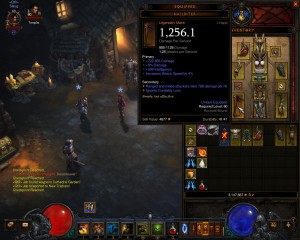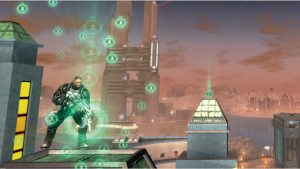Last week two very different games released grand changing patches: Diablo 3 and Payday 2. Both were designed around the same purpose of bringing people back to playing with new challenges and rewards. However, while people are enjoying Diablo 3, there has been an outcry over Payday 2 and this brings up the challenge of rewards and difficulty when it comes to game design.
Making the Right Carrot:
Before we talk about rewards, let’s go over the recent changes. Diablo 3 released patch 2.0, bringing the PC version in line with the console in terms of loot balancing as well as getting the game ready for the upcoming expansion. You can read more about this in my post spotlighting the changes.
Payday 2 had what Overkill is calling the Death Wish update. First, there was a redesign across the difficulty levels of how stealth works. Now it is a lot harder, or even impossible on some maps to take out every guard one at a time and have the level to yourself.
But the big change came in the form of the new difficulty, of course titled Death Wish. Death Wish is Payday 2‘s version of the original’s infamous Overkill 145 difficulty or expert mode. Here, when you play a level on death wish, the levels feature slight variations such as unbreakable cameras, more obstacles and harder fights.
Harder fights as in enemies spawn more, move faster, aim quicker have more health and damage and there are two new enemies. Elite units with heavy armor and the affectionately titled “Skulldozer”: a heavy unit wielding a light machine gun with heavy damage.
Overkill has also introduced a new challenge: If you can beat every map on each of the difficulty levels, you’ll receive a unique mask for each. But as we mentioned earlier, people are not happy about Payday 2‘s changes.

Extrinsic rewards like new gear or aesthetic options are great at pushing a player through an experience.
The problem is twofold, one being the intense difficulty increase that was added in the patch and the other is motivation or rewarding the player for taking on the challenge.
The difficulty increase can be a separate topic and one we’re not going to focus too much on here, but rewarding the player.
What it comes down to is that no matter the player, they want to be rewarded for playing a hard game or harder difficulty. Now I know that there are expert players out there getting ready to respond with “But playing a hard game is its own reward for me,” and they are right. However playing a challenging video game does provide an intrinsic reward.
There is a certain thrill with being able to beat something difficult, we see this in games like Ninja Gaiden Black or Dark Souls. Hell, you should probably throw a congratulatory party for yourself after beating that game. But there is a saying that I keep coming back to: It’s easy to make a hard game, but a challenging one is a different matter.
In order for a hard game to be intrinsically rewarding there are several factors that need to be in place. First is that the game has to be fair to the player in the sense that it can’t be needlessly difficult.
Elements like just raising enemy stat values doesn’t change the game, it just means the player is going to have to spend more time grinding or fighting. Ninja Gaiden Black is a great example of making a game harder by actually changing the enemies you would fight based on your difficulty level. Harder enemies reacted quicker, had new attacks and challenged the player differently.
Another no-no is restricting options. In the sense that if you let the player have a variety of skills, power-ups etc, but then say that there is only one or two ways to beat the game on hard mode that doesn’t work. Because you’re making the game less varied at the higher levels and forces the player into a black and white experience of pass or fail unless they do X.
Moving on let’s talk about extrinsic rewards which is a lot easier to discuss. Basically anything that provides some kind of a bonus or award to the player counts as an extrinsic example. So loot, achievements, even a new avatar picture on your profile is an example. Extrinsic rewards don’t all have to be game changing, but they do need to have an impact of some kind.
The most important aspect behind extrinsic rewards compared to intrinsic, is that they need to always be within the player’s grasp. This is where that compulsion to play ARPGs comes from: That your next piece of loot is always around the corner.
You can see the difference in the right and wrong way of extrinsic rewards when comparing Crackdown to GTA in terms of collectibles. In Crackdown, every agility orb provided both a short and long term reward for collecting them.
While in the GTA series, you only received a reward for collecting certain # of special packages or killing pigeons in GTA 4.
So while the former provided constant rewards, the latter only did after the player performed enough tasks with nothing in between. With that said, let’s go back to Payday 2 and Diablo 3 to see where the differences lie.
Measuring the Stick:
Diablo 3‘s biggest change from launch to patch 2.0 is how rewards are delivered. Instead of going long periods of time without finding anything good and then getting that one amazing piece, loot is now designed around a gradual and tighter increase in improvement. So you’re going to find better loot quicker and work your way up to that bad-ass level, instead of just getting their all of a sudden.
This is the right way of building an extrinsic reward system as it constantly motivates the player to move forward. Intrinsically, there is the thrill at playing on Diablo 3′s newly redesigned difficulty levels which combines both intrinsic and extrinsic for a great experience.
The problem with Payday 2 at the moment is that neither side is fully developed with the new Death Wish mode. Intrinsically, the higher difficulty doesn’t feel balanced to the skill trees and equipment currently in the game, and requires an almost robotic like method of playing to stand a chance.
Again extrinsically, the promise of a new mask but only after going through all the heists doesn’t really work. A possible alternative for example, beating each heist unlocked something in game like something for the safe house or a specialty mask in of itself, which could provide some motivation along the way towards the big prize.

Intrinsic rewards only work if the game was properly balanced to provide a challenge without featuring cheap difficulty mechanics.
For the last point of this piece, I want to touch on the question of what is better: intrinsic or extrinsic value?
This is an interesting point and I feel that this is more about the person rather than the design. For me, I could care less about achievements and more about the challenge involved.
But at the same time, I don’t want to play something that is hard just for the sake of being hard, I want to be challenged with something new and exciting that wouldn’t have been possible on the easier difficulty settings. That doesn’t mean that I don’t like rewards like hats and aesthetic items, but I want them to be attached to a meaningful action.
Understanding how people are motivated to play your game is an important consideration; not everyone wants to play a game for either one or the other. And while having both intrinsic and extrinsic options are great, they need to be paired with a tough but fair difficulty system to truly get the impact right.



